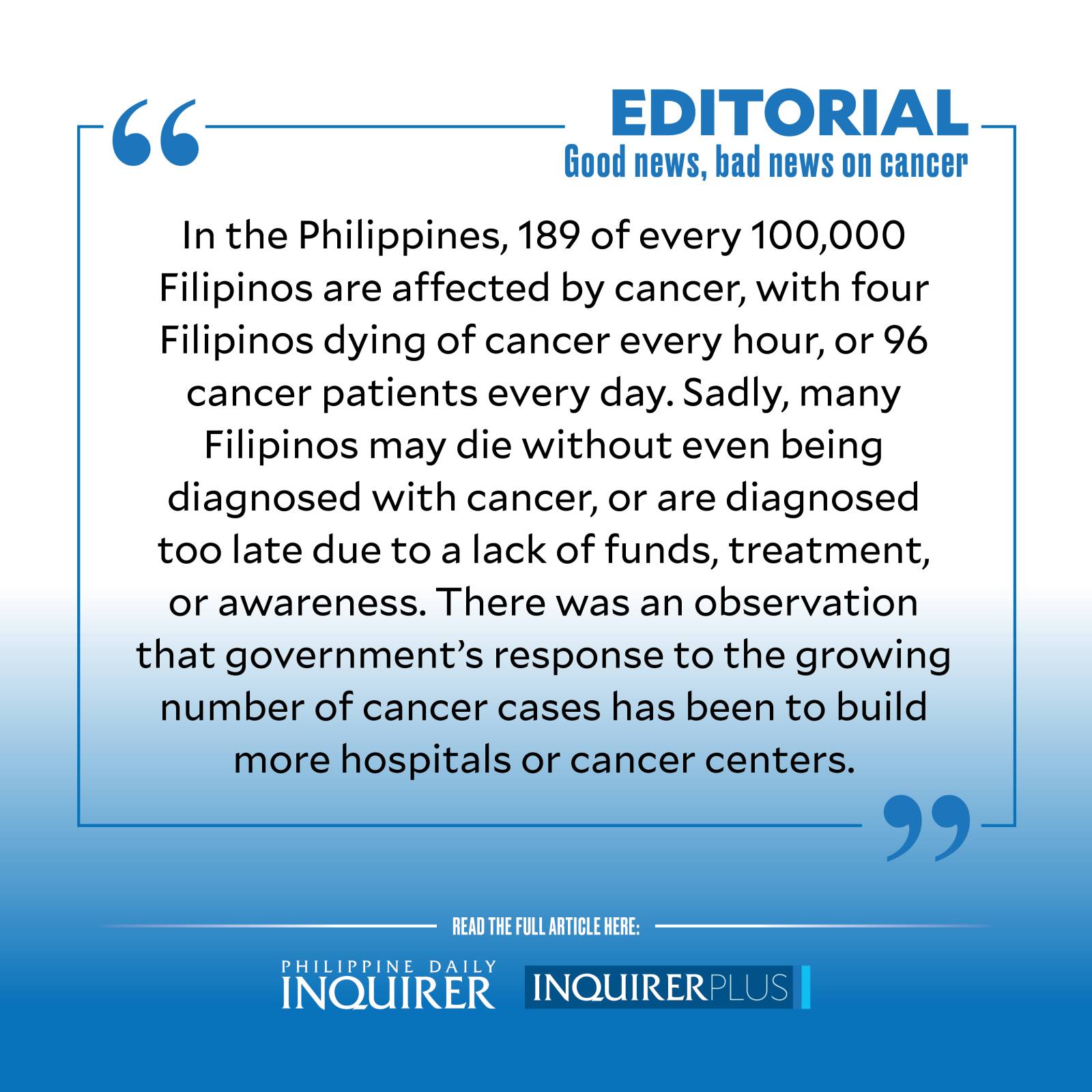Good news, bad news on cancer

There’s been good news and bad news recently about cancer in this country. First, the good news: The Department of Budget and Management (DBM) has announced that it has released to the Department of Health (DOH) P500 million for the 2023 cancer assistance fund (CAF). The amount, said DBM Secretary Amenah Pangandaman, is the government’s way of boosting the health and welfare of cancer-stricken Filipinos, to complement and supplement existing financial support mechanisms for various cancer care and control services that are not yet covered by the Philippine Health Insurance Corp. (PhilHealth), and are only partially covered by the Malasakit Program.
Last year, the DBM released P529.2 million for the CAF, of which the DOH utilized P230.8 million. The balance of P298.4 million may still be used until the end of the year, according to the DBM.
But this positive development is offset by news of an official filing criminal and administrative complaints against seven health officials, including DOH OIC Maria Rosario Vergeire, for the alleged mismanagement of P786 million meant for cancer care, plus the P529 million for the CAF.
Dr. Clarito Cairo Jr., who used to head the DOH’s cancer control and prevention program, alleged that the DOH “sub-allotted” last year’s funding to fewer hospitals and supposedly purchased pricey medicines for cancer patients.
Given the scarcity of funds for health care, acute health care especially, the misuse or misallocation of whatever money is made available is shocking and criminal.
This bit of dismaying news, if true, is made worse by the fact that, according to University of the Philippines-Philippine General Hospital medical oncology fellow Dr. Kenneth Samala, there are only 300 oncologists or specialists in cancer treatment nationwide. These 300 specialists, most of them practicing in Metro Manila, are expected to serve a population of more than 100 million Filipinos.
Adding to the gravity of the situation is the fact that cancer, with 31,487 deaths recorded last year, is the third leading cause of death in the country, next to heart diseases and cerebrovascular diseases (strokes). Cancer is also the second leading cause of death worldwide, with approximately 10 million mortalities (or nearly one in every six deaths) recorded in 2020. The most common cancers, according to the World Health Organization, are those of the lungs, breast, colon, rectum, and prostate. In the Philippines, 189 of every 100,000 Filipinos are affected by cancer, with four Filipinos dying of cancer every hour, or 96 cancer patients every day. Sadly, many Filipinos may die without even being diagnosed with cancer, or are diagnosed too late due to a lack of funds, treatment, or awareness.
There was an observation that government’s response to the growing number of cancer cases has been to build more hospitals or cancer centers. But the real need, Samala said, is to develop more cancer experts and “get trainees who, after being trained, can go back to their communities and serve.”
Aileen Antolin of the Philippine Foundation for Breast Care Inc. echoed Samala’s views, noting that there is a need to train more experts, like oncologists and pathologists, to attend to the needs of cancer patients. “What I have observed is that the funding is usually being used to build infrastructure, although what should be highlighted is the need for manpower or experts … There is a cancer center, but there are no oncologists, surgeons, pathologists, radiologic technologists, and mammography technologists. What happens is we just build structures, we acquire machines, but we lack experts (who can operate) the facility and equipment.” Indeed, of what use is a spanking-new, state-of-the-art facility without the experts and knowledgeable medical personnel to make use of it?
And what of the cancer patients themselves? Cancer is one of four epidemic noncommunicable diseases (NCDs) or lifestyle-related illnesses. The others are cardiovascular disease, diabetes mellitus, and chronic respiratory disease. According to DOH, NCDs are now regarded as a massive “silent disaster” ravaging the country’s population. The death toll of NCDs has been compared to “two 747 planes packed with passengers colliding every day.” Risk factors have been identified as being linked to cancer, including tobacco use, an unhealthy diet, insufficient physical activity, and harmful alcohol use.
These may seem like common sense observations, but they call for discipline, temperance, and lifestyle changes. This is true not just for cancer but for most diseases leading to morbidity and mortality. This, too, is good news and bad news for all those concerned about their survival and quality of life.




















